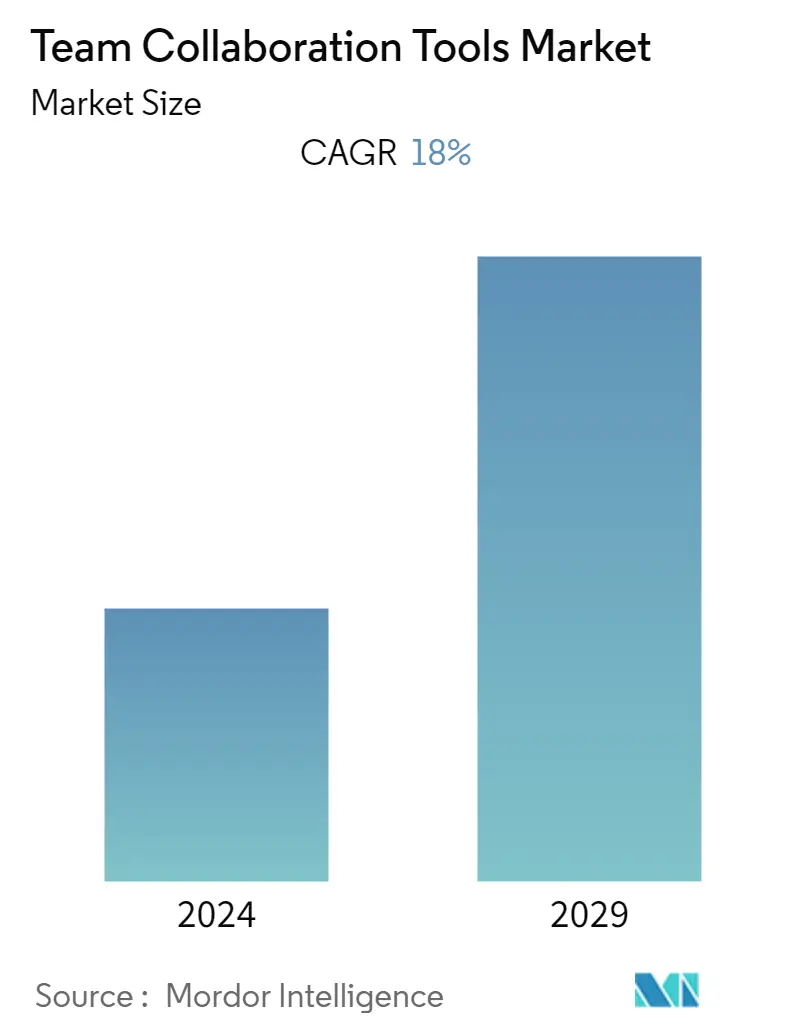Market Size of Team Collaboration Tools Industry

| Study Period | 2019 - 2029 |
| Base Year For Estimation | 2023 |
| CAGR | 18.00 % |
| Fastest Growing Market | Asia Pacific |
| Largest Market | North America |
| Market Concentration | Medium |
Major Players
*Disclaimer: Major Players sorted in no particular order |
Team Collaboration Tools Market Analysis
The team collaboration tools market will register a CAGR of 18% over the forecast period. Team collaboration tools are a subclass of collaboration platforms. They have certain features in common, but the main distinction is that team collaboration tools concentrate on real-time messaging and can take the place of email among teams. Voice calls and video conferencing are two additional features of team collaboration tools.
- The term "team collaboration tools" or "team collaboration software" refers to various software programs and online resources that businesses and individuals can utilize to work effectively on shared projects, regardless of their physical location or appearance. The tools can range from a straightforward email tool to a highly complex project management tool. The main objective of a team collaboration tool is to enable a group of two or more people to achieve a common goal by supporting them and synchronizing their efforts.
- Further, to achieve automation and better communication inside a business, it is anticipated that the developments of artificial intelligence and its integration with team collaboration tools will increase demand. A significant team benefit of artificial intelligence is greater productivity and attention to high-value work, as expected by most enterprises.
- Additionally, with cloud collaboration, every team member has an equal chance to contribute, and they may do it whenever they want, from wherever they are. By using cloud computing to share information and interact, projects can be finished more quickly and with higher-quality results. On-premise apps have lost ground to cloud-based online collaboration solutions in market share, which now exceeds 50%.
- Unfortunately, there are still issues with team collaboration tools despite the availability of various features and applications. For instance, if too many individuals participate with divergent viewpoints, the convenience of offering input may turn out to be detrimental, and the original worker may lose focus on their initial goal. Roadblocks can also be caused by a lack of team management or the capacity to specify essential performance indicators (KPIs) and precise objectives.
- Team collaboration technologies are anticipated to rise in response to the COVID-19 pandemic. Due to the lockdown, many businesses are encouraging the use of team collaboration solutions since, during a crisis, employees frequently work from home. The transition of enterprises to remote work resulted in a 40% increase in demand for Microsoft Teams, a team collaboration tool from Microsoft. As remote meetings become the norm rather than the pre-pandemic exception, Microsoft announced new Teams tools intended to enhance them.
Team Collaboration Tools Industry Segmentation
Team collaboration tools engage in helping project managers and teams manage changes, communicate, save time, and remain effective at the same time. The team collaboration tools market is segmented by type of deployment (cloud and on-premise), organization size (small and medium enterprises and large enterprises), and geography (North America, Europe, Asia-Pacific, Latin America, and Middle East and Africa). The market sizes and forecasts are provided in terms of value (USD million) for all the above segments.
| By Type of Deployment | |
| Cloud | |
| On-premise |
| By Organization Size | |
| Small and Medium Enterprises | |
| Large Enterprises |
| By Geography | ||||||
| ||||||
| ||||||
| ||||||
| ||||||
|
Team Collaboration Tools Market Size Summary
The team collaboration tools market is experiencing significant growth, driven by the increasing need for real-time communication and project management solutions that can replace traditional email systems. These tools, which include features such as voice calls and video conferencing, are designed to enhance productivity by enabling teams to work together effectively, regardless of their physical location. The integration of artificial intelligence into these tools is expected to further boost demand by automating tasks and improving communication within organizations. Cloud-based solutions are gaining popularity over on-premise applications, as they offer greater flexibility and accessibility, allowing team members to contribute from anywhere at any time. Despite the advantages, challenges such as managing diverse viewpoints and setting clear objectives remain.
The North American region is anticipated to hold a significant share of the team collaboration tools market, driven by the rapid adoption of web conferencing and collaboration portals. The presence of major players like Microsoft Corporation and Slack Technologies Inc. in the US, along with technological advancements, contributes to this growth. The market is moderately consolidated, with established companies holding a majority share and facing competition from new entrants. Recent developments include Microsoft's introduction of new collaboration features and Slack's partnership with Salesforce to enhance team performance. These advancements reflect the ongoing evolution of team collaboration tools, which continue to adapt to the changing needs of businesses.
Team Collaboration Tools Market Size - Table of Contents
-
1. MARKET INSIGHTS
-
1.1 Market Overview
-
1.2 Industry Attractiveness - Porter's Five Forces Analysis
-
1.2.1 Bargaining Power of Suppliers
-
1.2.2 Bargaining Power of Consumers
-
1.2.3 Threat of New Entrants
-
1.2.4 Threat of Substitutes
-
1.2.5 Intensity of Competitive Rivalry
-
-
1.3 Assessment of the Impact of COVID-19 on the Industry
-
-
2. MARKET SEGMENTATION
-
2.1 By Type of Deployment
-
2.1.1 Cloud
-
2.1.2 On-premise
-
-
2.2 By Organization Size
-
2.2.1 Small and Medium Enterprises
-
2.2.2 Large Enterprises
-
-
2.3 By Geography
-
2.3.1 North America
-
2.3.1.1 United States
-
2.3.1.2 Canada
-
-
2.3.2 Europe
-
2.3.2.1 Germany
-
2.3.2.2 United Kingdom
-
2.3.2.3 France
-
2.3.2.4 Rest of Europe
-
-
2.3.3 Asia-Pacific
-
2.3.3.1 India
-
2.3.3.2 China
-
2.3.3.3 Japan
-
2.3.3.4 Rest of Asia-Pacific
-
-
2.3.4 Latin America
-
2.3.4.1 Brazil
-
2.3.4.2 Argentina
-
2.3.4.3 Rest of Latin America
-
-
2.3.5 Middle East and Africa
-
2.3.5.1 United Arab Emirates
-
2.3.5.2 Saudi Arabia
-
2.3.5.3 Africa
-
2.3.5.4 Rest of Middle East and Africa
-
-
-
Team Collaboration Tools Market Size FAQs
What is the current Team Collaboration Tools Market size?
The Team Collaboration Tools Market is projected to register a CAGR of 18% during the forecast period (2024-2029)
Who are the key players in Team Collaboration Tools Market?
Microsoft Corporation, Slack Technologies Inc., Smartsheet Inc., Asana Inc. and Atlassian Corporation PLC are the major companies operating in the Team Collaboration Tools Market.

